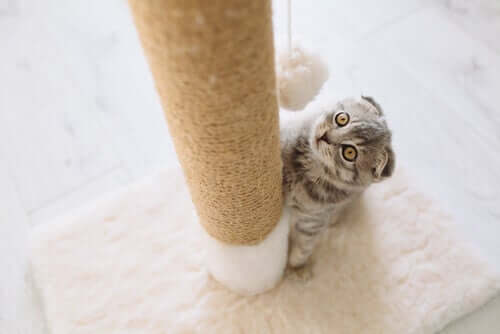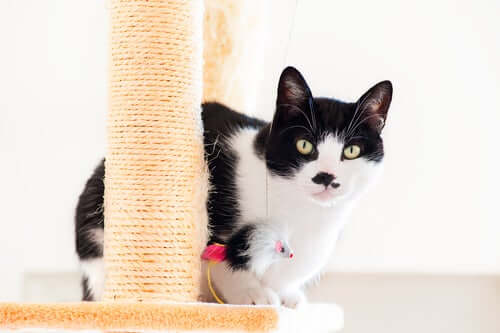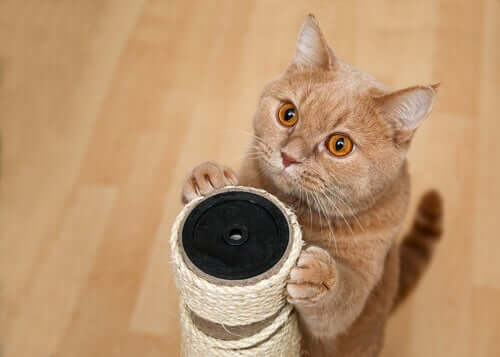All about Scratching Posts for Cats

Scratching posts are very important for cats because the habit of scratching is very essential and natural for them.
Although many owners believe that cats scratch things around them to damage them on purpose, it’s actually an instinctive action for them. The idea that cats want to break something is humanizing these animals in a sense. Instead, you should actually try to find out more about cats’ natural instincts in order to understand why they do what they do.
To avoid your cat damaging your things, you should buy a scratching post for it. These posts are designed for cats to scratch them and forget the rest of the furniture around them.
You can buy one for your cat or you can even make one yourself!
The importance of scratching
Some owners don’t understand that, for cats, scratching an object is the same as what sleeping, breathing, eating, or exercising is for humans.
Basically, scratching relaxes cats because it allows them to stretch (thus avoiding tension) and even allows them to mark their territory.
In addition, when they scratch, cats sharpen their claws and this makes them grow stronger and healthier. Remember that claws are essential to cats.
Cats don’t really know what they’re scratching. For them, any object can serve this purpose.
The good news is that you don’t have to wait for your cat to destroy your home. Also, you won’t have to resort to the horrible practice of clipping your cat’s nails to “solve” the problem. Actually, the solution is much easier: scratching posts!
Types of cat scratching posts
There are many different types of scratching posts. They’re designed for both indoor and outdoor use. In addition, some scratching posts fit any space, as they come with accessories to lengthen or shorten them.

Other scratching posts are designed for other uses as well. For example, some posts come with beds. Other posts are even incorporated into a cat “playground”.
You can find a lot of cat scratching post options in pet stores.
If you have more than one cat, we recommend that you get each of them their own scratching post to avoid problems between them. It’s important for cats to have their own personal scratching post.
The most common scratching posts are:
1. Basic cat scratching post
It consists of a tall pole with a foundation for it to stay upright and another foundation on top for sturdiness. They may be wrapped in sisal twine or other rugged materials. This basic design allows cats to stretch on two hind legs and scratch with their forelegs. It’s one of the cheapest types of scratching posts.
2. Scratching posts with accessories
Some posts come with accessories such as a cat house or playground for your cat.
If you have enough space, it’s an excellent choice for you. They may include one or more caves or boxes for your cat to hide in, stairs, and various levels that will entertain your cat for hours. Ideal for playful cats!
3. Flat scratching posts
This type is best suited for small kittens and if you don’t live in a big place. It’s like a kind of frame with a pad that allows the animal to scratch without having to exert too much pressure.
They’re also good for adult cats or those who can’t make overly “athletic” moves. It’s very easy for you to make one yourself if you wish.
4. Cardboard cat scratching post
This is the cheapest of all scratchers.
If you have a cat, you surely know that they’re fascinated with cardboard boxes. No matter what’s inside this post, your cat will have fun for hours! Your cat will hide, sleep, scratch, and have fun inside it!
How to make a cat scratching post
If you like arts and crafts and have some free time, you can even make your own cat scratching post. It’s easier than you think!

Materials
- 1 wooden stick (of the same height as your cat)
- 2 wooden squares (their sides should measure half the stick)
- Sandpaper
- Sisal twine
- Carpet scraps
- Glue
- Nails and hammer
Steps to follow
- Sand the wood to remove all splinters and uneven surfaces that can hurt your cat.
- Line the square wooden pieces with the previously selected carpet scraps (on both sides). Place glue on the wooden stick and wrap the sisal twine around it as tight as you can.
- Hammer both the foundation and the top to the ends of the wooden stick.
- Let everything dry well.
- Introduce it to your cat and let the fun begin!
If you want, you can add a few string or wool balls to draw your cat’s attention.